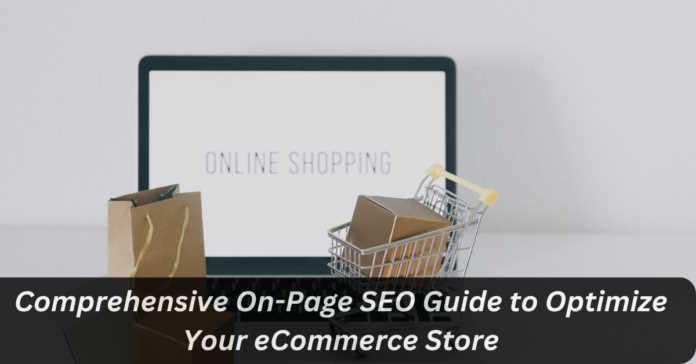On Google, people usually start their product search with specific phrases/queries. If you don’t optimize your online store for user-search keywords, people won’t find you, and you will lose sales. How to avoid this? Follow the best on-page SEO practices mentioned in this checklist. This will help in making your site appear in SERP results for related queries. Let’s understand the most significant SEO parameters that you must consider to boost your website’s online rankings and user experience in 2023.
Table of Content:
Complete eCommerce Onpage SEO Checklist to Boost Online Rankings & Growth
- Optimize URL Structure
- Optimize Content for Mobile-first Indexing
- Add Breadcrumbs on Product Pages
- Increase Dwell Time through Visually Engaging Elements
- Map Search Intent with Keywords to Create Valuable Content
- Use Unique Title Tags
- Add User-searched Phrases/Keywords in Headings & URL
- Avoid Duplicate & Thin Content
- Optimize Product Images
- Use Single H1 Tags
- Strategically Provide Internal Linking in Content
- Improve Website Navigation for Enhanced User Experience
- Improve Ratings & Reviews
Conclusion
Complete eCommerce Onpage SEO Checklist to Improve Online Rankings & Growth
To improve your eCommerce website’s online ranking and boost growth, it is essential to optimize your site’s content and elements based on the best on-page SEO practices. This includes:
1. Optimizing URL Structure
A clear and concise URL helps search engines understand what the product page is about and index it accordingly. To optimize the URL structure of product pages for search engines, include the product category, item details, and targeted keywords in it.
Some examples:
“latestfashion.com/red-dress-women-clothing.html”
“myntra.com/blue-tshirt-men-clothing.html”
“homedecor.com/cushions/boho-printed-cushion-covers.html”
Few additional tips to keep in mind during URL optimization:
- Keep it short and clear, not more than 70 characters.
- Use hyphens to separate the words instead of underscores or spaces.
- Do not use special characters.
- Keep the URL structure consistent for all pages of the website.
2. Optimizing Content for Mobile-first Indexing
Google prefers a mobile version of a content piece for indexing and ranking on SERP – a concept called Mobile-first indexing. It means Google analyzes the responsiveness and content of your mobile site to consider it for ranking. If your website’s content is not optimized for different device screen sizes, it may not be considered for indexing and your rankings might be affected.
Enhance your website’s mobile-first experience with these tips:
- Ensure your website automatically adjusts its layout and elements based on screen size for both desktop and mobile devices. Use Google’s mobile-friendly test tool to check its responsiveness.
- Optimize the visual elements for quick loading of the mobile version of your site for an enhanced user experience.
- Keep the details in the content and its quality the same for both desktop and mobile versions.
- Use a common structured data markup for mobile and desktop versions.
- Submit a sitemap via Google Search Console to speed up the crawling and indexing of your site.
- Ensure there are no fragmented URLs in the mobile version and test the site on various devices such as tablets, smartphones, etc.
3. Adding Breadcrumbs on Product Pages
A breadcrumb trail is a navigational aid that shows users which page they are currently viewing and the path they have followed to reach there. It allows users to quickly navigate to higher-level parent pages and go back to the previously visited pages with a single click. This can be extremely useful for eCommerce sites with large product catalogs.
By implementing breadcrumb schema and creating internal linking between product pages, you can help search engines understand the structure of your website and index your pages more effectively.
But how to use breadcrumbs efficiently on your website? Here are some tips:
- Don’t use breadcrumbs only on the homepage, but on all pages.
- Like your URL structure, keep the breadcrumbs descriptive, clear, and consistent across all pages.
4. Increasing Dwell Time through Visually Engaging Elements
As image search is getting popular on Google, it is crucial to incorporate visually engaging elements on your product pages to grab users’ attention. Infographics, carousels, product videos, etc., increase the dwell time (average session duration) and the chances of conversions by providing more information about a product.
Metrics like dwell time and customer engagement rate indicate to search engines that your site is providing value to users. That is why most of the popular brands, like Nike, Adidas, Sephora, etc., utilize visual elements to engage customers and improve their dwell time.
5. Mapping Search Intent to Keywords for Creating Valuable Content
Google’s recent update emphasizes showing search results that closely match the user intent. To create valuable content that resonates with your target audience, you must first understand what they’re searching for.
For example, upon searching “best beard shaver” on Google, you will mostly find informative results. This indicates that people are using this keyword for product research instead of buying. Now, you can use this keyword strategically in your content to provide information about your product or create an informative guide to suggest the best beard shavers people can consider.
To make your content more engaging and valuable for users, you can:
- Highlight product features using bullet points for easy readability and include relevant long-tail keywords.
- Include an FAQ section on your product page to answer common queries.
- Add all the crucial information about the item, like manufacturer’s details, pricing, warranty, how-to-use, return policy, and more in the product description.
- Add social media handles and modes of communication so users can use them to reach out to you.
The more transparent your website content is, the more trustworthy and helpful it will be considered by search engines.
6. Using Unique Title Tags
Meta titles are not only important for search engines to understand the context of your page but also for users. By keeping your title tags unique and compelling, you can improve CTR (click-through rate) and online visibility. Search engines avoid duplicate tags because they make it difficult for them to determine which page is the most relevant for a given search query.
There is a lot of scope for creativity when crafting unique title tags. You can try different variants by adding the target keyword, power words, CTA, numbers, and brand name. Once you understand which type of title tags are working for you, adopt that strategy for all pages. For better results, keep the title tags short (within 60 characters) and crisp.

7. Adding User-searched Phrases/Keywords in Headings & URL
Search engines use URL structure and headings (H1 and H2) to understand the context of a page. To improve your rankings, optimize these two sections with user-searched keywords. You can use Google Analytics site search report and keyword research tools like Ahrefs, Semrush, Google’s Keyword Planner, etc., to find the relevant user-search phrases.
Some best ways to utilize targeted keywords in your website’s content are discussed below.
- The targeted keyword should be used in the H1 heading because it serves as the page title and has the highest chance of grabbing the users’ attention.
- If you have several long-tail keywords that users usually search for, try to incorporate them in H2 or other subheadings.
- To avoid competition with yourself, do not use the same targeted keyword in the headings and URL structure of different pages. If done, it might confuse Google as to which page is more relevant to users for specific queries.
8. Avoiding Duplicate & Thin Content
Both thin and duplicate content can kill your online rankings by indicating to search engines that your website provides no value to users.
Thin content is low-quality content lacking images, detailed information, and other crucial elements. While duplicate content is identical or nearly identical to other content on the web, confusing search engines which one is more relevant for users.
By fixing thin and duplicate content on your eCommerce site, you can improve your online rankings and attract more visitors. Here are some ways to do this:
For thin content:
- Add images, videos, and other multimedia content to your pages.
- Provide detailed information about your products and services.
- Use keywords and phrases throughout your content to make it relevant to search engines.
For duplicate content:
- Use canonical URLs to tell search engines which page is the original version of the content.
- Redirect duplicate pages to the original page.
- Delete duplicate pages if they are not necessary.
9. Optimizing Product Images
In eCommerce, product images are crucial for users to better understand what an item is and its features or appearance. Google Image Search drives significant organic traffic to eCommerce sites. The key to image rankings lies in optimizing ALT tags, which convey image context to search engine crawlers.
To optimize your images for SEO, use descriptive alt text (within 125 characters) that includes relevant keywords. You should also give your images descriptive file names that are easy to understand like “Black Full Sleeve Women Dress L Size.”
Another crucial aspect is file size. High-quality images can slow down page loading due to their large file size, impacting ranking and user experience. As an on-page SEO practice, always compress large-size files to ensure quick loading on mobile and desktop devices. This can enhance the overall user experience on your site.
10. Using Single H1 Tag
For search engines, H1 is the highest priority content. When you use multiple H1 tags on a page, it can dilute the ranking power of your most important heading. It can also make the page structure difficult to understand for search engines. Multiple H1 tags can confuse the crawlers and give search engines the impression that you are trying to game the system by including more keywords for ranking purposes.
To avoid such problems, it is best to only use one H1 tag on a page. Make sure this tag is unique and contains your primary keyword. You can use other heading tags, such as H2 and H3, to structure your page and provide additional information.
11. Providing Internal Linking in Content Strategically
Internal linking should be well-thought and well-implemented on eCommerce sites as it gives you the opportunity of showcasing similar or related products to users for cross-selling. Also, it makes it easier for users to find relevant information and move from one page to another seamlessly.
Through internal linking, you can pass authority to other pages to improve their rankings. But while creating internal links, here are a few things you must keep in mind:
- Add relevant links at appropriate phrases.
- Don’t overstuff your content with too many internal links. Ideally, there should not be more than 5-10 internal links for a 2,000 words content piece.
- Don’t place links on similar text as it will confuse readers and search engines.
- Add links to the important pages only.
12. Improving Website Navigation for Enhanced User Experience
As Google and other search engines prioritize delivering the best experience to users, eCommerce sites with exceptional user interface and navigation have more chances to rank higher.
The more sorted your website navigation, the more quickly and effortlessly users will be able to find the desired product, enhancing customer engagement and online conversions.
But how to improve the navigation of your site? Here are some best practices:
- Use clear, concise, and easy-to-understand labels for main menu navigation links.
- Add a search bar and faceted search functionality to enable users quickly find or filter products based on their attributes.
- Minimize the number of clicks required to find a product or reach the checkout page.
- Keep your navigation mobile-friendly & use breadcrumbs.
13. Improving Ratings & Reviews
All your on-page SEO efforts are in vain if you don’t have positive reviews and high ratings on your website, as they are the ultimate trust factors that drive more sales. Search engines also consider it a crucial ranking factor as it indicates how trustworthy a website is. Sites with positive product reviews and good ratings always get more preference in SERP results over sites with poor feedback. Ratings and review on an eCommerce website also directly affect the purchase decisions of users.
A few tips to improve reviews and ratings on your eCommerce store:
- Make it easy for customers to leave reviews on your site with a simple feedback form.
- Respond to both positive and negative reviews to improve customer service.
- Avoid fake reviews as search engines penalize sites that follow this practice, and it can affect your rankings.
Conclusion
These on-page SEO parameters are crucial for eCommerce sites to optimize content, enhance user experience, and boost search engine visibility & rankings. However, that is not all. To maintain stable rankings, you must focus on post-publishing tasks, such as monitoring site performance, fixing broken links, and updating content regularly. By doing these, you can stay competitive in search engine rankings and drive sustained organic traffic to your eCommerce site.
However, if you find it difficult to manage these tasks in-house, consider outsourcing eCommerce SEO services to experts who can boost your store rankings and visibility through their targeted strategies and proven experience.
Author Bio:
Jessica Campbell is an eCommerce consultant and content strategist. She has published over 2000 articles & informative write-ups about eCommerce & Amazon marketplace solutions covering Amazon listing optimization, Amazon PPC management services, Amazon SEO & marketing, Amazon store setup, and Amazon product data entry. Her well-researched and valuable write-ups have helped thousands of businesses uncover rich insights, strengthen their business processes, and stay afloat amidst the rising competition.












